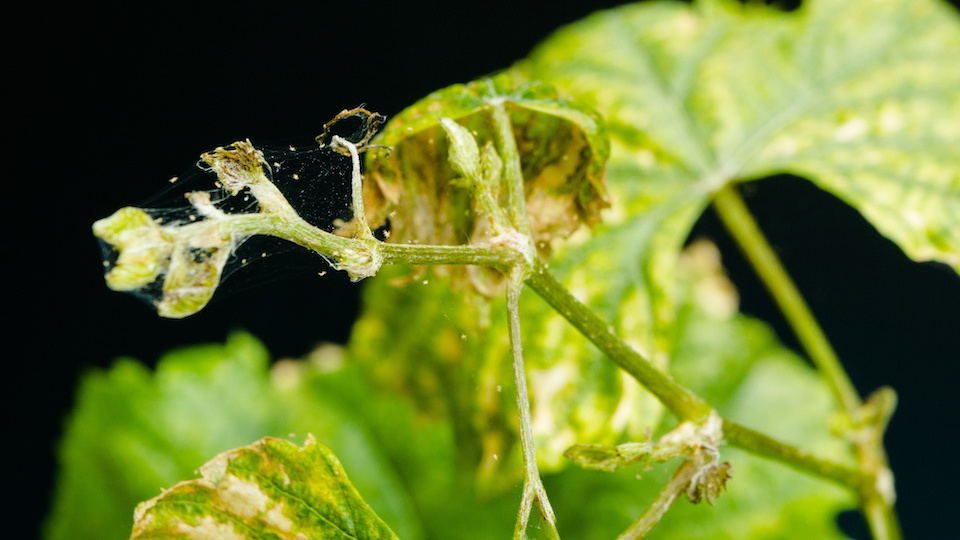If your houseplants are dying and you can’t figure out why, you might have a pest problem on your hands. Here are a few of the most common indoor plant pests and how to get rid of them for good.
Aphids
Perhaps the most easily identified indoor plant pests, aphids lurk on the underside of leaves and leave a distinctive dew-like substance behind as they feed. They may be green, black, brown, or pink and prefer new, tender growth, so if you suspect an infestation, be sure to double-check small leaves. They can also be identified by the damage they cause, usually yellowed or browned leaves or dead branches and stems.
What to do: Thankfully, aphids are fairly easy to deal with compared to other plant pests. Simply spray them off of the leaves with a spray bottle and wipe down your plant with a warm, moist cloth to catch any stragglers. Insecticidal soap may be a beneficial follow-up to keep the aphids from returning and ensure that all of the bugs are gone.
Fungus gnats
Many plant parents struggle with overwatering, which is even more of an issue if you are trying to deal with fungus gnats and restore the health of your damaged plant. These bugs thrive in moist soil and feed on algae and plant roots, killing your plants from the roots, which can be incredibly hard to recover from. The adults are tiny black flies no more than ⅕ of an inch long, while the larvae are small clear worms with black heads.
What to do: Since fungus gnats thrive on algae and moist plant materials, watering less if one of the best ways to starve them out and deal with the problem for good. Water only when the top inch or two of soil is dry and be sure to avoid letting your plant sit in water.
Spider mites
Spider mites are incredibly common and can often slip under the close watch of an indoor gardener due to their minute size. They multiply incredibly quickly and can take over a plant in a matter of weeks, leaving behind an unsightly spider-like webbing. They will also cause yellow specks as they suck out the sap from the leaves. In order to identify these tiny creatures, wipe a white tissue across the underside of the leaves. If the tissue has red specks on it (mite blood), it’s likely that your plant is afflicted by these pests.
What to do: Though spider mites can be difficult to identify, they are actually relatively easy to get rid of. Simply use some insecticidal spray or horticultural oils on your plant, and the pests will die in just a few hours.
Mealybugs
Mealybugs will leave behind clumps of white fuzz on the leaves, but you will usually find the actual insects in the elbow of the stalk, where the new growth begins. These pests are larger than others on this list but are often difficult to eradicate since they are so adept at hiding.
What to do: Since they are so large, you can use a paintbrush to remove each individual mealybug and egg cluster from your plant, by brushing them into a paper towel (don’t let the bugs fall into the soil). Be sure to inspect the plant thoroughly for any remaining bugs and then treat with organic insecticidal soap.
Thrips
Thrips can be incredibly hard to spot since they are tiny black bugs that live on the underside of leaves. They are particularly fond of certain varieties of philodendron and monstera and are known to attack the main vein of the leaf, cutting off the direct route of water and nutrients.
What to do: Use an insecticidal soap 3-4 times each week until your plant is able to recover and most of the thrips are dead.
Best ways to prevent infestation
While the above tips will help you deal with certain bugs that have invested individual plants, the best way to avoid a war against pests is prevention. These helpful ideas will give your houseplants the best chance for survival and aid in keeping your home pest-free.
Inspect plants before you buy: If you see any signs of pests, avoid buying that plant and notify a nursery worker so that they can quarantine the affected plant.
Always use clean soil and pots: Avoid planting anything in a used pot if it hasn’t been cleaned thoroughly with soap and water.
Monitor for pests: Though this tip will only be useful if you already suspect a pest invasion, keeping sticky traps around your houseplants will allow you to monitor the health of your plants. If you notice flying or crawling bugs getting caught in the traps, attempt to identify the insect and which plant it came from so that you can exercise proper eradication practices.
-Susan Patterson




